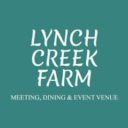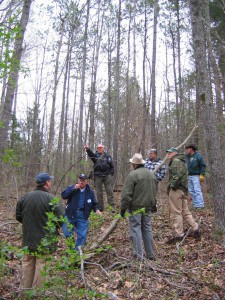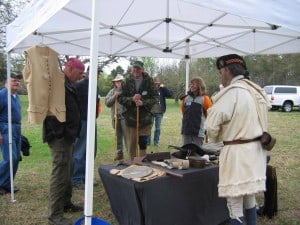2008-APR > Lynch Creek Mill Tour with Tom Magnuson
Lynch Creek Mill Tour with Tom Magnuson
Those who attended included: Joe Elmore, John Rogers, Joanne Carpenter, William Spencer, C.L. Gobble, Louis Wheless & son, Billie Lumpkin, Bill Hill & son, Peter Andrews, Tasker Southerland and Gary Cunard. This event was organized by Bob Radcliffe to highlight the rich historical and archaeological fabric of the Lynch Creek watershed that has long been overlooked and nearly forgotten. Tom Magnuson is an expert on the “contact era” settlement patterns of North Carolina. He focuses upon finding Indian trading paths – the highways of the past – to locate fords across streams and permanent settlement areas with commerce vs. earlier nomadic transient habitation. Tom explained that mills were usually located near fords to service patrons from both sides of a waterway; and that fords (at mills) were always downstream from the last mill structure; and that dams and raceways were often more than 1000 feet upstream from the mill itself. Tom Magnuson, CEO Trading Path Association (right) and Gary Cunard, publisher The Franklin Times (center) Using GPS (Global Positioning Equipment), Tom mapped both Mill Sites and located the mill dam, mill race and relief, and mill wheels. More detailed mapping of these sites remains to be performed. Much of the historical infrastructure of Franklin County is poorly inventoried and documented. It is hoped that this event, and other concurrent activities like the Franklin County Heritage Book, will renew interest and perhaps trigger the formation of an active Franklin County Historical Society. Effort will be made by Joe Elmore and others to do so. After exploring the Gill Mill (last operated c.a. 1900), and the much larger Whitaker Mill (last operated c.a. 1950), the group was treated to a Revolutionary War Soldier demonstration by Billy Jarrell of the Ridgeway Opry House. Tom Magnuson locates a ford by sighting across Lynch Creek at elevation We chose to focus upon the Revolutionary War period on this tour because it has been overshadowed by the Civil War. The pre-Civil War historical record of North Carolina holds greater significance to the history of the United States of America. The unwritten history of Franklin County in the Revolutionary War period will eventually be recorded to reveal the lives and actions of prominent Americans that inhabited the area north of the Tar River The group weathered the rain showers and cool weather, to talk and share their observations until nearly 5:00pm. As the day came to a close, it seemed that most wished it could have continued forever; however, . . . Billy Jarrell in authentic Revolutionary War attire, Joe Elmore (far left), Tom Magnuson (left), William Spencer (center), Joanne Carpenter (right) . . . Tom Magnuson had to depart, and speak at the Granville County Genealogical Society meeting in Oxford, NC at 6:30pm. Several in attendance chose to drive to Oxford and experience Tom’s slideshow and talk about the Indian Trading Path that passed nearby Oxford. If you belong to an organization, you can request Tom to come speak, by simply submitting a request to the NC Humanities Council – Roads Scholar Program – we highly recommend him! If you want to read more about Lynch Creek Mills, checkout Tom’s April 2008 Newsletter at |




Leave a Reply